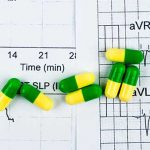- Tramadol Half-Life
- Tramadol Drug Tests & Detection Times
- Urine Tests
- Blood Tests
- Saliva Tests
- Hair Tests
Tramadol is an opioid analgesic (pain medication) sold under the brand names Ultram and Conzip. Although it can be effective for treating severe pain and chronic pain, tramadol also has a risk of abuse and dependence.
If you or a loved one struggles with tramadol dependence, a drug test may help you determine if you need substance abuse treatment.
Tramadol can stay in your system for 30 to 80 hours, depending on the type of tramadol. A drug test can detect tramadol for up to 4 days in urine and up to 90 days in hair follicles.
Tramadol Half-Life
The half-life of tramadol is the amount of time it takes the drug to reach half its concentration in your blood. It takes about five half-lives for a drug to be eliminated, however, several factors can impact elimination times.
Higher doses and heavy tramadol use can cause it to stay in a person’s system longer. In addition, body composition, metabolic rate, and how you use the drug (orally, snorting, injecting) can affect how long tramadol stays in your system.
Immediate-release, or fast-acting, tramadol has a half-life of about 6 hours and the active drug is eliminated within 30 hours. Extended-release tramadol has a half-life of about 16 hours, which means it can last just over 3 days in your system.
Tramadol Drug Tests & Detection Times
Tramadol is metabolized primarily in the liver, where it creates metabolites that can last even longer than the drug itself. However, tramadol and its metabolites are not detected on most standard drug tests.
If someone is suspected of tramadol abuse, there are specific tests that can detect the tramadol’s metabolites.
Urine Tests
A urine test is one of the most common types of drug screening available. After last use, tramadol can be detected 1-3 days later in urine. Several factors, including kidney and liver function, can affect the drug’s metabolism.
Blood Tests
A blood test is the most invasive type of drug testing and it has the shortest detection window. Tramadol is only detected in blood for about 12-24 hours after the last dose, depending on your body’s metabolic rate.
Saliva Tests
Saliva tests also have a short window of detection but they can offer accurate results. Saliva samples can offer instant results or be sent to a lab to test for specific metabolites. Tramadol is only detected in saliva for up to 48 hours after last use.
Hair Tests
When tramadol is broken down in your body, the metabolites can enter your scalp and hair follicles. A hair follicle test provides the largest window of detection. Tramadol and its metabolites can be detected for up to 90 days after the last dose.
Tramadol Dependence
If you have a positive drug screen, it’s possible you have a physical dependence on tramadol.
Dependence is a result of changes in the brain caused by repeated drug use. When you take tramadol, it activates opioid receptors to provide pain relief.
It also inhibits the reuptake of serotonin and norepinephrine causing an increased amount to be utilized by brain cells. Side-effects of tramadol may include euphoria, drowsiness, and constipation.
However, heavy tramadol use can cause your brain and body to rely on the drug to function. If you try to cut back or stop drug use, you may experience withdrawal.
Tramadol withdrawal symptoms may include:
- sweating
- goosebumps
- anxiety
- irritability
- nausea
- diarrhea
- intense cravings
Dependence may be associated with a higher tolerance, which means you need higher amounts of the drug to feel the pleasurable side effects. This increases the risk of taking too much of the drug and experiencing a potentially life-threatening overdose.
Tramadol Addiction Treatment
Tramadol dependence may also be a sign of a substance use disorder (SUD), also known as addiction. If you think you are addicted to tramadol, there are a variety of evidence-based treatment options that can help you learn how to maintain long-term recovery.
Depending on your individualized treatment plan, you may have access to:
Medical Detox
A medical detox program can help you safely through the withdrawal process. A team of healthcare professionals will monitor your symptoms and provide medication, if necessary.
Inpatient Rehab
Inpatient rehab is an intensive treatment program with 24/7 supervision. You will engage in daily therapeutic groups that may include behavioral therapy, support groups, and 12-step facilitation.
Outpatient Rehab
Outpatient rehab programs provide weekly treatment sessions based on your needs. At Northeast Addictions Treatment Center, we offer a wide range of comprehensive outpatient treatment options that include behavioral therapy, family therapy, and individual counseling.
For more information, please contact us today.
Sources
- Dove Medical Press: Journal of Pain Research — Review Of Extended-Release Formulations Of Tramadol For The Management Of Chronic Non-Cancer Pain: Focus On Marketed Formulations
- Federal Practitioner — A Practical Guide To Urine Drug Monitoring
- National Library Of Medicine: Medline Plus — Tramadol
- State Of Nebraska Judicial Branch — Laboratory Testing Reference Guide
Written by
Northeast Addition Editorial Team
©2024 Northeast Addition Center | All Rights Reserved
This page does not provide medical advice.







